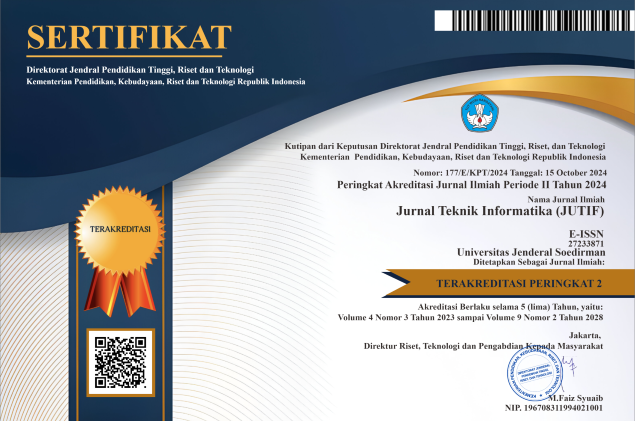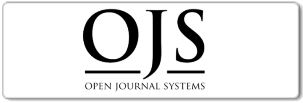AN ENHANCED MULTI-LAYERED IMAGE ENCRYPTION SCHEME USING 2D HYPERCHAOTIC CROSS-SYSTEM AND LOGISTIC MAP WITH ROUTE TRANSPOSITION
DOI:
https://doi.org/10.52436/1.jutif.2025.6.1.4007Keywords:
Chaotic, C2HM, Hyperchaotic, Image Encryption, Logistic Map, Transposisi RouteAbstract
In the rapidly evolving digital era, image encryption has become a crucial technique to protect visual data from the threat of information leakage. However, the main challenge in image encryption is improving security against cryptanalysis attacks, such as brute-force and differential attacks, which can compromise the integrity of the encrypted image. Additionally, the creation of efficient and fast encryption schemes that do not degrade image quality remains a significant challenge. This research proposes a multi-layer image encryption scheme that integrates the Logistic Map algorithm, Cross 2D Hyperchaotic (C2HM) system, and Route Transposition techniques. The method aims to enhance the security of digital image encryption by combining chaotic and hyperchaotic systems. The Logistic Map is used to generate a sequence of random values with high chaotic properties, while C2HM contributes to increasing complexity and variability. The Route Transposition technique is applied to scramble pixel positions, further strengthening the encryption’s randomness. The encryption key is derived from a combination of the image hash and user key, which are then used to calculate the initial seed in the chaotic algorithm. Experiments were conducted using standard images with a resolution of 512×512 pixels. The security analysis includes evaluations of NPCR, UACI, histogram analysis, and information entropy. The experimental results show that NPCR consistently exceeds 99.5%, while UACI ranges between 33.23% and 33.56%, indicating high sensitivity to minor changes. Histogram analysis demonstrates an even intensity distribution, and the information entropy value of 7.999 reflects an exceptionally high level of randomness. Robustness tests also indicate that this method can maintain image integrity even when subjected to damage or data loss.
Downloads
References
A. K. Jain, S. R. Sahoo, and J. Kaubiyal, “Online social networks security and privacy: comprehensive review and analysis,” Complex and Intelligent Systems, vol. 7, no. 5, pp. 2157–2177, Oct. 2021, doi: 10.1007/S40747-021-00409-7/FIGURES/10.
S. Sugiyatno, P. Sidiq, and I. F. Edrisy, “Pengaruh Teknologi 5G pada Evolusi Komunikasi: Sebuah Kajian Terhadap Perkembangan dan Implikasinya di Bidang Sains,” NUCLEUS, vol. 4, no. 2, pp. 115–120, Feb. 2024, doi: 10.37010/nuc.v4i2.1448.
S. Zhao and M. Zappavigna, “Beyond the self: Intersubjectivity and the social semiotic interpretation of the selfie,” New Media Soc, vol. 20, no. 5, pp. 1735–1754, May 2018, doi: 10.1177/1461444817706074.
N. Kshetri, “The evolution of cyber-insurance industry and market: An institutional analysis,” Telecomm Policy, vol. 44, no. 8, Sep. 2020, doi: 10.1016/j.telpol.2020.102007.
A. Setyono, D. R. I. M. Setiadi, and Muljono, “StegoCrypt method using wavelet transform and one-time pad for secret image delivery,” Proceedings - 2017 4th International Conference on Information Technology, Computer, and Electrical Engineering, ICITACEE 2017, vol. 2018-January, pp. 203–207, Jul. 2017, doi: 10.1109/ICITACEE.2017.8257703.
A. Singh, K. B. Sivangi, and A. N. Tentu, “Machine Learning and Cryptanalysis: An In-Depth Exploration of Current Practices and Future Potential,” Journal of Computing Theories and Applications, vol. 1, no. 3, pp. 257–272, Feb. 2024, doi: 10.62411/JCTA.9851.
D. R. I. M. Setiadi, R. Robet, O. Pribadi, S. Widiono, and M. K. Sarker, “Image Encryption using Half-Inverted Cascading Chaos Cipheration,” Journal of Computing Theories and Applications, vol. 1, no. 2, pp. 61–77, Oct. 2023, doi: 10.33633/jcta.v1i2.9388.
B. Zhang and L. Liu, “Chaos-Based Image Encryption: Review, Application, and Challenges,” Mathematics 2023, Vol. 11, Page 2585, vol. 11, no. 11, p. 2585, Jun. 2023, doi: 10.3390/MATH11112585.
P. N. Andono and D. R. I. M. Setiadi, “Improved Pixel and Bit Confusion-Diffusion Based on Mixed Chaos and Hash Operation for Image Encryption,” IEEE Access, vol. 10, pp. 115143–115156, 2022, doi: 10.1109/ACCESS.2022.3218886.
J. Oravec, L. Ovsenik, and J. Papaj, “An image encryption algorithm using logistic map with plaintext-related parameter values,” Entropy, vol. 23, no. 11, Nov. 2021, doi: 10.3390/e23111373.
Muhammad Rizki, Erik Iman Heri Ujianto, and Rianto Rianto, “Digital Image Encryption Using Logistic Map,” Jurnal RESTI (Rekayasa Sistem dan Teknologi Informasi), vol. 7, no. 6, pp. 1292–1299, Nov. 2023, doi: 10.29207/resti.v7i6.5389.
S. Zhu and C. Zhu, “Secure image encryption algorithm based on hyperchaos and dynamic DNA coding,” Entropy, vol. 22, no. 7, Jul. 2020, doi: 10.3390/e22070772.
M. Kaur, D. Singh, and V. Kumar, “Improved seven-dimensional (i7D) hyperchaotic map-based image encryption technique,” Soft comput, vol. 26, no. 6, pp. 2689–2698, Mar. 2022, doi: 10.1007/S00500-021-06423-8.
M. Jin, K. Sun, and H. Wang, “Hyperchaos, extreme multistability, and hidden attractors in the novel complex nonlinear system and its adaptive hybrid synchronization,” Nonlinear Dyn, vol. 110, no. 4, pp. 3853–3867, Dec. 2022, doi: 10.1007/S11071-022-07770-3/METRICS.
T. Nestor et al., “A New 4D Hyperchaotic System with Dynamics Analysis, Synchronization, and Application to Image Encryption,” Symmetry 2022, Vol. 14, Page 424, vol. 14, no. 2, p. 424, Feb. 2022, doi: 10.3390/SYM14020424.
L. Teng, X. Wang, F. Yang, and Y. Xian, “Color image encryption based on cross 2D hyperchaotic map using combined cycle shift scrambling and selecting diffusion,” Nonlinear Dyn, vol. 105, no. 2, pp. 1859–1876, Jul. 2021, doi: 10.1007/s11071-021-06663-1.
X. Xue, D. Zhou, and C. Zhou, “New insights into the existing image encryption algorithms based on DNA coding,” PLoS One, vol. 15, no. 10, Oct. 2020, doi: 10.1371/journal.pone.0241184.
X. Huang, Y. Dong, G. Ye, W. S. Yap, and B. M. Goi, “Visually meaningful image encryption algorithm based on digital signature,” Feb. 01, 2023, KeAi Communications Co. doi: 10.1016/j.dcan.2022.04.028.
A. Susanto, A. Sari, E. H. Rachmawanto, M. Doheir, W. Bagus Nugroho, and C. A. Sari, “A ROBUST AND IMPERCEPTIBLE FOR DIGITAL IMAGE ENCRYPTION USING CHACHA20,” vol. 5, no. 2, pp. 397–404, 2024, doi: 10.52436/1.jutif.2024.5.2.1470.
P. Parida, C. Pradhan, X. Z. Gao, D. S. Roy, and R. K. Barik, “Image Encryption and Authentication with Elliptic Curve Cryptography and Multidimensional Chaotic Maps,” IEEE Access, vol. 9, pp. 76191–76204, 2021, doi: 10.1109/ACCESS.2021.3072075.
O. Dişkaya, E. Avaroǧlu, H. Menken, and A. Emsal, “A New Encryption Algorithm Based on Fibonacci Polynomials and Matrices,” Traitement du Signal, vol. 39, no. 5, pp. 1453–1462, Oct. 2022, doi: 10.18280/TS.390501.
M. Kaur, D. Singh, V. Kumar, B. B. Gupta, and A. A. Abd El-Latif, “Secure and energy efficient-based E-Health care framework for green internet of things,” IEEE Transactions on Green Communications and Networking, vol. 5, no. 3, pp. 1223–1231, Sep. 2021, doi: 10.1109/TGCN.2021.3081616.
X. Qian, Q. Yang, Q. Li, Q. Liu, Y. Wu, and W. Wang, “A Novel Color Image Encryption Algorithm Based on Three-Dimensional Chaotic Maps and Reconstruction Techniques,” IEEE Access, vol. 9, pp. 61334–61345, 2021, doi: 10.1109/ACCESS.2021.3073514.
X. Gao, “Image encryption algorithm based on 2D hyperchaotic map,” Opt Laser Technol, vol. 142, Oct. 2021, doi: 10.1016/j.optlastec.2021.107252.
S. Zhou, Y. Wei, Y. Zhang, and L. Teng, “Novel Chaotic Image Encryption Using Dynamic DNA Coding,” 2023, doi: 10.21203/rs.3.rs-2650537/v1.
E. Winarno, K. Nugroho, P. W. Adi, and D. R. I. M. Setiadi, “Combined Interleaved Pattern to Improve Confusion-Diffusion Image Encryption Based on Hyperchaotic System,” IEEE Access, vol. 11, pp. 69005–69021, 2023, doi: 10.1109/ACCESS.2023.3285481.


























